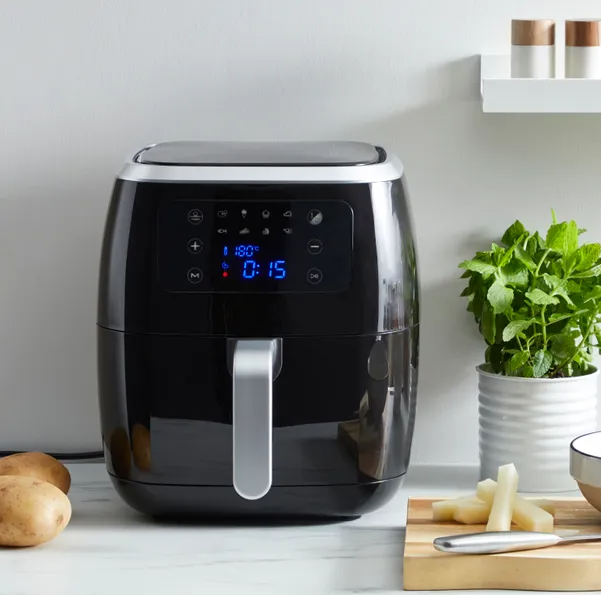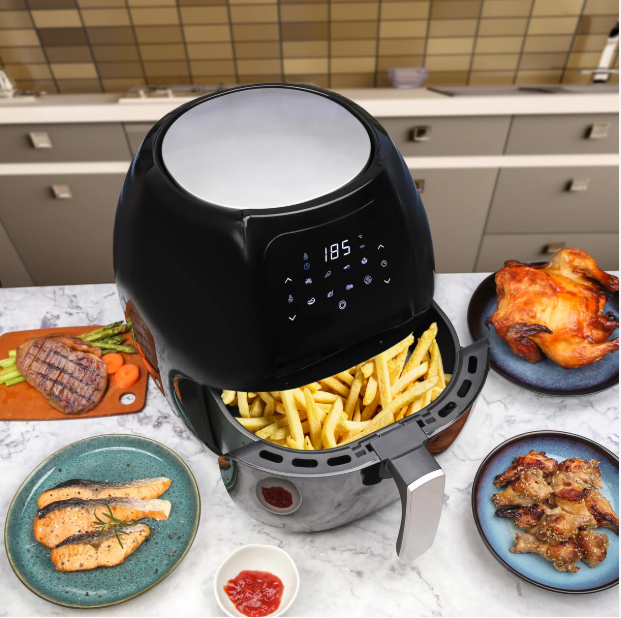Hello, food lovers! Chef Airkit here, straight from the Airkit Home test kitchen. Let’s talk about something I’m truly passionate about: creating mouth-watering food that’s both good for us and kind to our planet. For years, we’ve faced a dilemma: the crispy, golden-brown deliciousness we crave often comes at an environmental cost. But what if I told you there’s a game-changing appliance that can give you perfect results while shrinking your carbon footprint? It’s time we dive deep into the world of the Eco Friendly Air Fryer and discover how this kitchen marvel is changing the way we cook for the better.
The first time I used an air fryer, I was hooked by its ability to make the crispiest chicken wings with just a teaspoon of oil. But as I explored its technology, I discovered its biggest secret: it’s not just a healthier way to cook, it’s a greener one, too. Are you ready to make your kitchen more sustainable without sacrificing flavor? Let’s get started.

What Exactly Makes an Air Fryer Eco-Friendly?
That’s the million-dollar question, isn’t it? The term “eco-friendly” gets thrown around a lot, but when it comes to air fryers, it’s backed by some serious science and practical benefits. It’s not just about a single feature; it’s a combination of factors that make this appliance a champion of sustainable cooking.
Energy Efficiency: The Biggest Green Win
Think about your conventional oven. To bake a tray of potatoes, you have to heat a large, insulated metal box, which can take 10-15 minutes just to preheat. It’s a bit like turning on the central heating for your entire house just to warm your hands.
An air fryer, on the other hand, is a master of efficiency. It works by circulating incredibly hot air at high speed in a very compact space. Imagine a super-powered, concentrated tornado of heat. This technology, called Rapid Air Technology, has two huge energy-saving advantages:
- Faster Preheating: Most air fryers, including our Airkit Home models, need little to no preheating time. You can often go from zero to cooking in under three minutes.
- Shorter Cooking Times: That intense, circulating heat cooks food up to 25% faster than a conventional oven.
As Dr. Elena Vance, a specialist in sustainable home technology, puts it: "The energy savings from an air fryer over its lifetime can be substantial. By cooking faster and using a smaller, more targeted heating element, it drastically reduces the kilowatt-hours consumed per meal compared to a traditional electric oven."
Reduced Oil Consumption: Good for You and the Planet
We all know air frying slashes fat and calories by using up to 85% less oil than deep-frying. But have you ever thought about the environmental impact of that oil? Producing cooking oil requires vast amounts of land, water, and energy for farming, harvesting, processing, and transportation.
By drastically cutting down your oil usage, you’re not just making a healthier choice for your body; you’re also reducing your reliance on an resource-intensive product. Plus, you eliminate the messy and environmentally problematic issue of disposing of large quantities of used cooking oil. An eco friendly air fryer helps you minimize waste from start to finish.
Sustainable Materials and Durability
The greenest product is the one you don’t have to replace. A key aspect of an eco friendly air fryer is its construction. While many appliances are made with flimsy plastics, conscious brands are increasingly using more durable and safer materials.
- Stainless Steel: Look for models with stainless steel bodies and internal components. It’s highly durable, recyclable, and doesn’t harbor odors or stains.
- BPA-Free Plastics: Ensure any plastic components that come into contact with food are certified BPA-free.
- Non-Toxic Coatings: The basket’s non-stick coating is crucial. Modern, high-quality air fryers use PFOA-free and PTFE-free ceramic coatings, which are safer for you and less harmful to the environment during production.
Investing in a well-built appliance from a reputable brand like Airkit Home means it will be a fixture in your kitchen for years, keeping one less appliance out of the landfill.
How to Choose the Right Eco Friendly Air Fryer for You
Feeling convinced? Great! Now, let’s navigate the options to find the perfect sustainable partner for your kitchen. Picking the right model is about matching the appliance’s features to your lifestyle to maximize its green potential.
What Size Air Fryer Is Most Efficient?
Choosing the right size is your first step in eco-conscious shopping. A single person or a couple will find a 2-4 quart air fryer perfectly adequate and highly efficient. For a family of four, a 5-7 quart model is ideal.
Why does this matter? Using a massive 8-quart air fryer to heat a handful of fries is inefficient. By choosing a size that fits your typical needs, you ensure you’re only using the energy required for the job, minimizing waste every time you cook.
Key Features to Look For
Beyond size, here are a few things I always tell my friends to look for:
- Check the Wattage: Lower wattage doesn’t always mean more efficient. A well-engineered 1500-watt air fryer can cook faster and more evenly than a poorly designed 1800-watt model. Check reviews that specifically mention cooking speed and performance.
- Inspect the Materials: As we discussed, prioritize stainless steel and certified non-toxic, non-stick coatings. It’s a sign of a quality product built to last.
- Brand Reputation and Warranty: A strong warranty is a company’s promise of quality. It means they’ve built a durable product and are willing to stand behind it. This is your best defense against premature e-waste.
Getting the Most Out of Your Air Fryer: Pro Eco-Tips
Owning an eco friendly air fryer is one thing; using it to its full green potential is another. Here are a few tips from my own kitchen to yours to make every meal a little more sustainable.
- Don’t Overcrowd the Basket: It’s tempting to stuff it full, but this blocks the airflow. Food will cook slower and less evenly, forcing you to extend the cooking time and use more energy. Cook in batches if you need to—it’s still faster than the oven!
- Batch Cooking is Your Friend: Since the air fryer is already hot, use that residual heat! After making your crispy salmon, toss in some asparagus for a few minutes. You get a whole meal done with the energy of one preheat cycle.
- Master the Reheat: Say goodbye to soggy, microwaved leftovers. An air fryer is fantastic at reviving day-old pizza, fries, or roasted chicken, making them taste freshly made. This simple habit can drastically cut down on your food waste. For a full guide, check out our post on reheating food in an air fryer.
- Clean for Longevity: A clean machine is an efficient machine. Caked-on grease and food particles can impede airflow and make the heating element work harder. Regular, gentle cleaning (as outlined in our air fryer cleaning guide) will extend the life of your appliance significantly.
Frequently Asked Questions
I get a lot of questions about making the switch to air frying. Here are some of the most common ones.

1. Is an air fryer really more energy-efficient than a conventional oven?
Yes, significantly. Due to its smaller size, rapid heating technology, and shorter cooking times, an air fryer can use up to 50% less energy than a full-sized conventional oven to cook the same meal.
2. What materials should I look for in an eco friendly air fryer?
Prioritize a stainless steel body for durability and a basket with a high-quality, PFOA-free, and ceramic-based non-stick coating. These materials are generally safer, last longer, and have a better environmental profile than cheaper plastics and older non-stick technologies.
3. How does using less oil actually help the environment?
Using less oil reduces the demand on agriculture (land, water, fertilizers), processing, and transportation associated with producing cooking oils. It also eliminates the environmental problem of disposing of large amounts of used fryer oil.
4. Can I use disposable parchment paper liners in my eco friendly air fryer?
While you can, a more sustainable option is to invest in a reusable silicone liner. These can be washed and reused hundreds of times, cutting down on single-use paper waste and saving you money in the long run.
5. Do air fryers create harmful fumes from their non-stick coatings?
High-quality, modern Air Fryers use stable, non-toxic coatings that are safe under normal cooking temperatures. To be extra safe, always choose a reputable brand that certifies its coatings as PFOA- and BPA-free, and never heat an empty basket for an extended period.
Your Crispy, Sustainable Kitchen Awaits
Let’s be honest, making sustainable choices can sometimes feel like a compromise. But that’s the beauty of this amazing appliance. Adopting an eco friendly air fryer into your routine isn’t about sacrifice; it’s about an upgrade. It’s about getting crispier, more delicious food on the table faster, all while using less energy, less oil, and creating less waste.
From my kitchen to yours, I encourage you to embrace this modern way of cooking. You’re not just buying another gadget; you’re investing in a healthier lifestyle and a healthier planet. Now, I’d love to hear from you—what’s the first eco-friendly meal you plan to make with your air fryer?